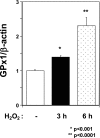Post-transcriptional defects of antioxidant selenoenzymes cause oxidative stress under methylmercury exposure
- PMID: 21106535
- PMCID: PMC3057802
- DOI: 10.1074/jbc.M110.168872
Post-transcriptional defects of antioxidant selenoenzymes cause oxidative stress under methylmercury exposure
Abstract
Methylmercury (MeHg) toxicity is a continuous environmental problem to human health. The critical role of oxidative stress in the pathogenesis of MeHg cytotoxicity has been clarified, but the molecular mechanisms underlying MeHg-mediated oxidative stress remain to be elucidated. Here we demonstrate a post-transcriptional effect of MeHg on antioxidant selenoenzymes by using a MeHg-susceptible cell line. MeHg-induced selenium deficiency leads to failure of the recoding of a UGA codon for selenocysteine and results in degradation of the major antioxidant selenoenzyme glutathione peroxidase 1 (GPx1) mRNA by nonsense-mediated mRNA decay (NMD), a cellular mechanism that detects the premature termination codon (PTC) located 5'-upstream of the last exon-exon junction and degrades PTC-containing mRNAs. In contrast, thioredoxin reductase 1 (TrxR1), another antioxidant selenoenzyme of the thioredoxin system, was likely skipped by NMD because of a UGA codon in the last exon. However, TrxR1 activity was decreased despite mRNA up-regulation, which was probably due to the synthesis of aberrant TrxR1 protein without selenocysteine. Changes in selenoenzyme GPx1 and TrxR1 mRNAs were observed earlier than was the incidence of oxidative stress and up-regulation of other antioxidant enzyme mRNAs. Results indicated that the MeHg-induced relative selenium-deficient condition affects the major antioxidant selenoenzymes GPx1 and TrxR1 through a post-transcriptional effect, resulting in the disturbance of cellular redox systems and the incidence of oxidative stress. Treatment with ebselen, a seleno-organic compound, effectively suppressed oxidative stress and protected cells against MeHg-induced relative selenium deficiency and cytotoxicity.
Figures









Similar articles
-
Diphenyl diselenide protects against methylmercury-induced inhibition of thioredoxin reductase and glutathione peroxidase in human neuroblastoma cells: a comparison with ebselen.J Appl Toxicol. 2017 Sep;37(9):1073-1081. doi: 10.1002/jat.3458. Epub 2017 Apr 6. J Appl Toxicol. 2017. PMID: 28383113
-
Additive pro-oxidative effects of methylmercury and ebselen in liver from suckling rat pups.Toxicol Lett. 2004 Feb 2;146(3):227-35. doi: 10.1016/j.toxlet.2003.10.001. Toxicol Lett. 2004. PMID: 14687760
-
Decreased plasma thiol antioxidant barrier and selenoproteins as potential biomarkers for ongoing methylmercury intoxication and an individual protective capacity.Arch Toxicol. 2016 Apr;90(4):917-26. doi: 10.1007/s00204-015-1528-3. Epub 2015 May 16. Arch Toxicol. 2016. PMID: 25975991
-
Methylmercury-Mediated Oxidative Stress and Activation of the Cellular Protective System.Antioxidants (Basel). 2020 Oct 16;9(10):1004. doi: 10.3390/antiox9101004. Antioxidants (Basel). 2020. PMID: 33081221 Free PMC article. Review.
-
Antioxidant function of thioredoxin and glutaredoxin systems.Antioxid Redox Signal. 2000 Winter;2(4):811-20. doi: 10.1089/ars.2000.2.4-811. Antioxid Redox Signal. 2000. PMID: 11213485 Review.
Cited by
-
Development of a sensor to detect methylmercury toxicity.Sci Rep. 2024 Sep 18;14(1):21832. doi: 10.1038/s41598-024-72788-z. Sci Rep. 2024. PMID: 39294331 Free PMC article.
-
Low level methylmercury enhances CNTF-evoked STAT3 signaling and glial differentiation in cultured cortical progenitor cells.Neurotoxicology. 2013 Sep;38:91-100. doi: 10.1016/j.neuro.2013.06.008. Epub 2013 Jul 8. Neurotoxicology. 2013. PMID: 23845766 Free PMC article.
-
Metals, oxidative stress and neurodegeneration: a focus on iron, manganese and mercury.Neurochem Int. 2013 Apr;62(5):575-94. doi: 10.1016/j.neuint.2012.12.006. Epub 2012 Dec 21. Neurochem Int. 2013. PMID: 23266600 Free PMC article. Review.
-
Endoplasmic reticulum stress preconditioning attenuates methylmercury-induced cellular damage by inducing favorable stress responses.Sci Rep. 2013;3:2346. doi: 10.1038/srep02346. Sci Rep. 2013. PMID: 23907635 Free PMC article.
-
Selenoneine, a novel selenium-containing compound, mediates detoxification mechanisms against methylmercury accumulation and toxicity in zebrafish embryo.Mar Biotechnol (NY). 2013 Oct;15(5):559-70. doi: 10.1007/s10126-013-9508-1. Epub 2013 May 25. Mar Biotechnol (NY). 2013. PMID: 23709046 Free PMC article.
References
-
- Hamada R., Osame M. (1996) Toxicology of Metals (Chang L. W. ed) pp. 337–351, CRC Press, London
-
- Bakir F., Damluji S. F., Amin-Zaki L., Murtadha M., Khalidi A., al-Rawi N. Y., Tikriti S., Dahahir H. I., Clarkson T. W., Smith J. C., Doherty R. A. (1973) Science 181, 230–241 - PubMed
-
- Davis L. E., Kornfeld M., Mooney H. S., Fiedler K. J., Haaland K. Y., Orrison W. W., Cernichiari E., Clarkson T. W. (1994) Ann. Neurol. 35, 680–688 - PubMed
-
- Deleted in proof.
-
- Park S. T., Lim K. T., Chung Y. T., Kim S. U. (1996) Neurotoxicology 17, 37–45 - PubMed
Publication types
MeSH terms
Substances
LinkOut - more resources
Full Text Sources
Other Literature Sources
Miscellaneous

